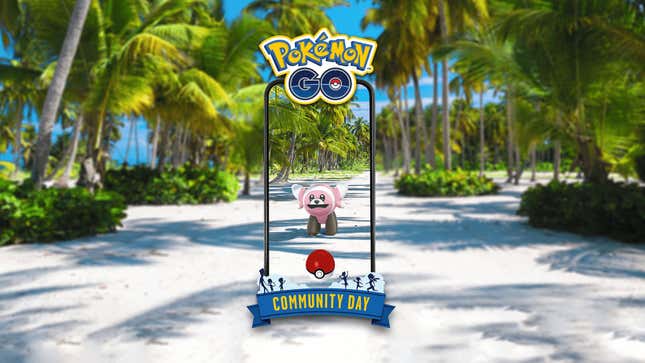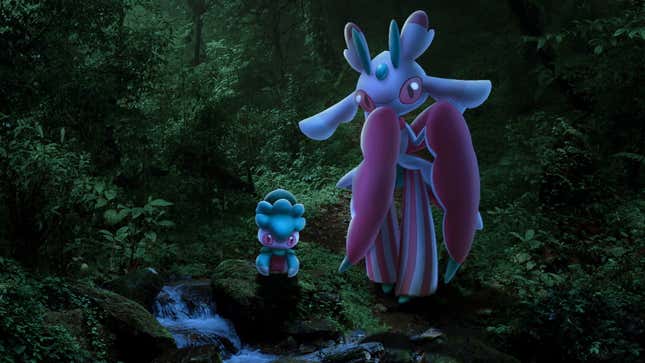Recent changes to Pokémon GO have yet again stirred controversy. The nerfing of Incense, and the halving of Community Day, have once more sent out a signal that Niantic wants the mobile game to return to its pre-pandemic form, before some of its audience is ready. We spoke to POGO’s live game director, Michael Steranka, to ask why the studio is trying to get people to gather as covid-19 cases spike, about those changes to Incense, and whether Pokémon GO has any plans to better cater to disabled players.
April’s Community Day, focusing on the freshly added Stufful, is to last only three hours: 2 p.m. to 5 p.m., your local time. That’s half the length the monthly event has been running for the last two years, a decision announced by Pokémon GO developers Niantic as a means to make the day a better chance for players to “play together and connect outside.” This is, they stated, motivated by their research that shows that only five percent of players take part for more than three hours anyway. I began by asking Michael Steranka, surely not the same three hours?
“Yeah, it is spread across the entirety of the six hours,” Steranka told us via a Zoom call. Sat in a gray room, the only visible detail being a graffitied orange girder stood up to his left, the game’s live director, and the original creator of Community Days, has strikingly Christ-like hair and beard. And like the J-man, he appears very fond of people gathering in public. Talking about how people’s chosen three hours or less were spread out across the day, he explained that this was—in Niantic’s view—the problem.
“That was actually one of the issues that we felt like there was, because you know, Community Day as it was intended is meant to actually get people out at the same time.” Steranka’s goal is to see Pokémon GO returning to its original roots, a game that has people meeting up outside, moving around, and finding their local community of players. He wants to see what he calls that “organic discovery of players around you,” explaining that in the early days of the game, this was how people made new friends.

Pokémon GO is certainly having a hard time finding its way back to those early days. Since March 2020, the game has been forced to make some fundamental changes to how it works, given a global audience who, in the face of a pandemic, suddenly couldn’t so easily (or safely) go outside to play. In order to maintain their player-base, some swift and smart changes were made that allowed the game to be far more playable while remaining home.
But Niantic really doesn’t want Pokémon GO to be a game people can play at home. Last September saw a quickly (although not nearly quickly enough) abandoned attempt to reverse some of those changes, as the developer inexplicably tried to get players out in public as the Delta variant was at its deadly peak. Now, as Omicron numbers are incredibly high (albeit far less deadly), it’s happening again. The timing feels...odd.
Steranka adds the familiar prefix that they “encourage players to follow local guidelines and regulations,” as well as to do what’s best for them in their local environment. But, he insists, “that’s not something we are trying to police on our side.” Instead he notes that they rely on their players to make sensible choices, and should people want to, the game remains totally playable on one’s own.
So what is in it for Niantic, then, to cut Community Day in half? Especially given the reaction to the news has not been positive. It’s here that Steranka brings up Niantic’s oft-stated three pillars. “First is exploration, the second is exercise, and the third is real-world social interactions. In terms of what we gain, it’s really us intending to lean into that.”
It seems important to the company that its games maintain this USP, that they be marked out from other mobile games by this roaming charge. “That’s a really meaningful thing for us,” Steranka adds, “We really want players to have that sense of their local community, and create bonds—and strength in bonds—because we really feel like that’s what sets our products apart from any other game out there.”
While it is hard not to be skeptical of a profit motive for making these changes so urgently, I was left in no doubt that the nerfing of Incense isn’t making Niantic any extra money. This month’s change saw the purchasable Incense creating just one encounter every five minutes when stationary, down from one a minute for the last two years.
“It’s definitely not to make more revenue on Incense,” Steranka laughs. “We’re making less revenue, because the item is less useful, right?” Again, the reason given is to return to those pillars, in this case the first two, exploration and exercise. “We never want Pokémon GO to be a product that you can fully complete and enjoy from your couch. And the fact of the matter is, with Incense being as powerful as it was, stationary players were able to do that, right?”
But cutting it down to a fifth as powerful, with no in-game warning? “The fine-tuned balancing of things is always a tricky balancing act,” Steranka concedes. “Where we really wanted to lean heavily was making sure that the in-motion bonus is stronger than ever. So we made sure that players are getting as many encounters as possible in motion. We also reduced the distance you need to move in order to trigger that in-motion bonus.”
Keen to point out pandemic changes that are to remain, like dropping the requirement to walk to take part in the GO Battle League, and the addition of daily field research, Steranka went as far as to call the previous Incense change “game-breaking.”
I returned to the point that, all this accepted, these changes were still poorly communicated to players. Millions of people have started playing the game in the last two years, many of them children who only then became old enough to play, and to them the game has always been like this. Can Niantic see that not communicating these reversals, and assuming audiences all remember how it used to be, creates a very negative response?
Acknowledging the issue, Steranka again returned to those stated core Niantic principles. He explained that he’s personally “pretty excited” to reintroduce the original ways of playing, “because those players haven’t experienced Community Day as it was before the pandemic.” His enthusiasm appears very genuine. “I really believe that is the most amazing three hours you can have in this game. And longtime players would vouch for that. The takeaway I hope people will have is, please suspend your disbelief until you’ve actually experienced this yourself.”

I couldn’t help thinking, throughout all this, about those for whom this is not a simple option. For two years, Pokémon GO has been a game that it’s possible to mostly play without having to walk anywhere. So for physically disabled players who’ve started playing at any point since March 2020, their full participation is all about to abruptly end.
“Yeah,” says Steranka, “that’s obviously the most challenging question, and we talk about that all the time here at Niantic.” He went on to talk more about how “the full game loop being playable from home just goes against a lot of our core tenets as a company.” Approaching this idea from a few different angles, and again concluding that making games “about exploring the real world” is where they excel, but at no point mentioning the disabled players about whom they think so much. I pressed that point. Are there any plans at all, given the amount of thought that’s gone into it?
“Nothing that I’m able to share today.” It’s a phrase that games journalists hear a lot when speaking to developers, but thinking optimistically, it’s usually rolled out when there are plans, but the studio is under strict instructions to keep them under wraps. Steranka adds, “But we are discussing it, and it is something that, as I mentioned, we are looking at new features and whatnot that should help in that regard.”
As to the future, Steranka spoke of plans for more city-specific community events to come in the game. Niantic plans on “identifying locations around the world where we could hand out some free Pokémon GO swag,” again through a desire to score those real-world social interactions. He also teased that this summer’s annual GO Fest event should have players excited, but said details were to be revealed soon.
Aside from asking him to extend PokéStop distances from 80 to 81 meters, so I can spin my nearest stop without going outside, that was where things drew to a close. And having pushed quite hard on the poor communication, the danger of covid, and the lack of visible support for recently joined disabled players, I suddenly and very unprofessionally thanked Steranka for his part in creating a game that—for all its changes—had given me and my own son some incredibly important happy times outdoors during the worst of the pandemic.
I think that’s the thing about Pokémon GO, the reason it maintains such a massive and regular audience almost six years after it came out. That outdoor stuff, even if it’s without “community-based social interaction,” is really important to what makes the game stand out, even as it hurts when the convenience of the pandemic changes is taken away. It’s a shame that Niantic appears to need to learn the lesson about communication over and over, but I have to admit I am looking forward to those moments of seeing a group of adults in the park, staring at their phones in a circle, and then smiling at each other as we realize we’re all doing the same weird-ass thing.